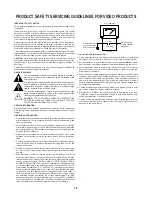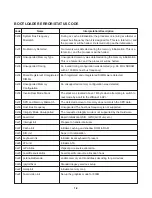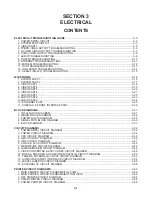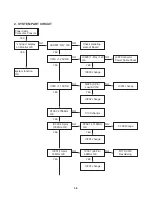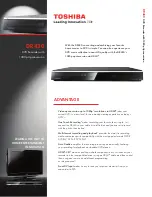
1-3
SERVICING PRECAUTIONS
CAUTION: Before servicing the HD/SD PERSONAL VIDEO
RECORDER & RECEIVER WITH GEMSTAR covered by
this service data and its supplements and addends, read and
follow the SAFETY PRECAUTIONS. NOTE: if unforeseen
circumstances create conflict between the following servic-
ing precautions and any of the safety precautions in this pub-
lications, always follow the safety precautions.
Remember Safety First:
General Servicing Precautions
1. Always unplug the HD/SD PERSONAL
VIDEO
RECORDER & RECEIVER WITH GEMSTAR AC power
cord from the AC power source before:
(1) Removing or reinstalling any component, circuit board,
module, or any other assembly.
(2) Disconnecting or reconnecting any internal electrical
plug or other electrical connection.
(3) Connecting a test substitute in parallel with an elec-
trolytic capacitor.
Caution: A wrong part substitution or incorrect
polarity installation of electrolytic capacitors may result
in an explosion hazard.
2. Do not spray chemicals on or near this HD/SD PERSON-
AL VIDEO RECORDER & RECEIVER WITH GEMSTAR
or any of its assemblies.
3. Unless specified otherwise in this service data, clean
electrical contacts by applying an appropriate contact
cleaning solution to the contacts with a pipe cleaner,
cotton-tipped swab, or comparable soft applicator.
Unless specified otherwise in this service data, lubrication
of contacts is not required.
4. Do not defeat any plug/socket B+ voltage interlocks with
which instruments covered by this service manual might
be equipped.
5. Do not apply AC power to this HD/SD PERSONAL VIDEO
RECORDER & RECEIVER WITH GEMSTAR and / or any
of its electrical assemblies unless all solid-state device
heat sinks are correctly installed.
6. Always connect the test instrument ground lead to an
appropriate ground before connecting the test instrument
positive lead. Always remove the test instrument ground
lead last.
Insulation Checking Procedure
Disconnect the attachment plug from the AC outlet and turn
the power on. Connect an insulation resistance meter (500V)
to the blades of the attachment plug. The insulation resis-
tance between each blade of the attachment plug and acces-
sible conductive parts (Note 1) should be more than 1M-
ohm.
Note 1: Accessible Conductive Parts include Metal panels,
Input terminals, Earphone jacks,etc.
Electrostatically Sensitive (ES) Devices
Some semiconductor (solid state) devices can be damaged
easily by static electricity. Such components commonly are
called Electrostatically Sensitive (ES) Devices. Examples of
typical ES devices are integrated circuits and some field
effect transistors and semiconductor chip components.
The following techniques should be used to help reduce the
incidence of component damage caused by static electricity.
1. Immediately before handling any semiconductor compo-
nent or semiconductor-equipped assembly, drain off any
electrostatic charge on your body by touching a known
earth ground. Alternatively, obtain and wear a commer-
cially available discharging wrist strap device, which
should be removed for potential shock reasons prior to
applying power to the unit under test.
2. After removing an electrical assembly equipped with ES
devices, place the assembly on a conductive surface such
as aluminum foil, to prevent electrostatic charge buildup or
exposure of the assembly.
3. Use only a grounded-tip soldering iron to solder or unsolder
ES devices.
4. Use only an anti-static solder removal device. Some
solder removal devices not classified as “anti-static” can
generate electrical charges sufficient to damage ES
devices.
5. Do not use freon-propelled chemicals. These can
generate an electrical charge sufficient to damage ES
devices.
6. Do not remove a replacement ES device from its protec-
tive package until immediately before you are ready to
install it. (Most replacement ES devices are packaged with
leads electrically shorted together by conductive foam,
aluminum foil,or comparable conductive material).
7. Immediately before removing the protective material from
the leads of a replacement ES device, touch the protective
material to the chassis or circuit assembly into which the
device will be installed.
Caution: Be sure no power is applied to the chassis or
circuit, and observe all other safety precautions.
8. Minimize bodily motions when handling unpackaged
replacement ES devices. (Normally harmless motion such
as the brushing together of your clothes fabric or the lifting
of your foot from a carpeted floor can generate static elec-
tricity sufficient to damage an ES device.)
Summary of Contents for LRM-519
Page 30: ...3 16 WAVEFORMS 1 SYSTEM PART 1 ...
Page 31: ...3 17 2 SYSTEM PART 2 ...
Page 32: ...3 18 3 VIDEO PART 1 ...
Page 33: ...3 19 4 VIDEO PART 2 ...
Page 34: ...3 20 5 VIDEO PART 3 ...
Page 35: ...3 21 6 VIDEO PART 4 ...
Page 36: ...3 22 AI_DATA AI_CLK AI_LRCLK 7 AUDIO PART 1 ...
Page 37: ...3 23 AUD_LINK_BCLK AUD_LINK_SDIN AUD_LINK_SYNC AUD_LINK_RST 8 AUDIO PART 2 ...
Page 38: ...SPDIF 3 24 AUDIO_L 9 AUDIO PART 3 ...
Page 39: ...3 25 TXD TXD RXIN RXIN 25MHZ 10 ETHERNET PART ...
Page 40: ...3 26 FLD_RXD FLD_CLK CLK_LPC_33MHZ 11 SUPER IO FRONT INTERFACE PART ...
Page 43: ...3 29 3 POWER BLOCK DIAGRAM ...
Page 45: ...3 31 5 BLOCK DIAGRAM ...
Page 46: ......
Page 48: ...3 34 3 35 2 POWER CIRCUIT DIAGRAM A B C D E F G H I J K L M N O P Q R S T ...
Page 49: ...3 36 3 37 3 CPU CIRCUIT DIAGRAM A B C D E F G H I J K L M N O P Q R S T ...
Page 50: ...3 38 3 39 4 GMCH CIRCUIT DIAGRAM A B C D E F G H I J K L M N O P Q R S T ...
Page 51: ...3 40 3 41 5 ICH4 CIRCUIT DIAGRAM A B C D E F G H I J K L M N O P Q R S T ...
Page 52: ...3 42 3 43 6 CLOCK LPC CIRCUIT DIAGRAM A B C D E F G H I J K L M N O P Q R S T ...
Page 53: ...3 44 3 45 7 MEMORY IDE CIRCUIT DIAGRAM A B C D E F G H I J K L M N O P Q R S T ...
Page 54: ...8 LAN USB MODEM CIRCUIT DIAGRAM A B C D E F G H I J K L M N O P Q R S T 3 46 3 47 ...
Page 57: ...3 52 3 53 11 TUNER EXTERNAL AV INPUT CIRCUIT DIAGRAM A B C D E F G H I J K L M N O P Q R S T ...
Page 59: ...3 56 3 57 13 MISCELLANEDUS CIRCUIT DIAGRAM A B C D E F G H I J K L M N O P Q R S T ...
Page 60: ...3 58 3 59 14 EXTERNAL I F CIRCUIT DIAGRAM A B C D E F G H I J K L M N O P Q R S T ...
Page 61: ...3 60 3 61 PRINTED CIRCUIT DIAGRAMS 1 MAIN PRINTED CIRCUIT DIAGRAMS TOP VIEW ...
Page 62: ...3 62 3 63 2 MAIN PRINTED CIRCUIT DIAGRAMS BOTTOM VIEW ...
Page 64: ...3 66 3 67 5 POWER PRINTED CIRCUIT DIAGRAM ...
Page 84: ...4 20 9 LASER TURN ON SIGNAL F LIC502 PIN 52 LDEN DVD LCN201 PIN17 VRDC LCN201PIN 34 ...
Page 99: ...4 35 2 Disc Specification 3 Disc Materials 1 DVD ROM Single Layer Dual Layer ...
Page 119: ...4 55 4 56 CIRCUIT DIAGRAMS 1 RF CIRCUIT DIAGRAM A B C D E F G H I J K L M N O P Q R S T ...
Page 120: ...4 57 4 58 2 DSP CIRCUIT DIAGRAM A B C D E F G H I J K L M N O P Q R S T ...
Page 121: ...4 59 4 60 3 µ COM CIRCUIT DIAGRAM A B C D E F G H I J K L M N O P Q R S T ...
Page 123: ...4 63 4 64 PRINTED CIRCUIT DIAGRAMS 1 MAIN P C BOARD LOCATION GUIDE ...



